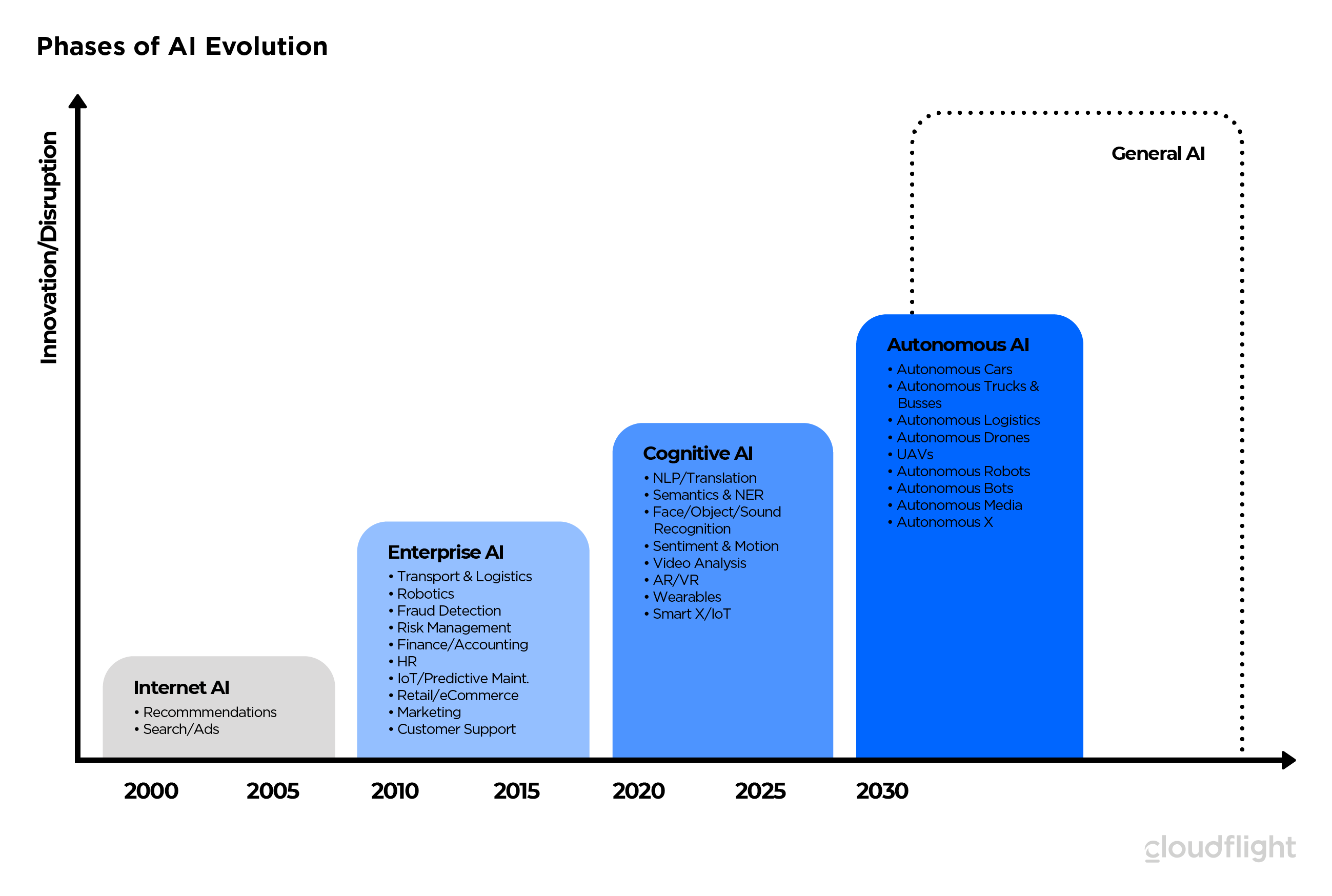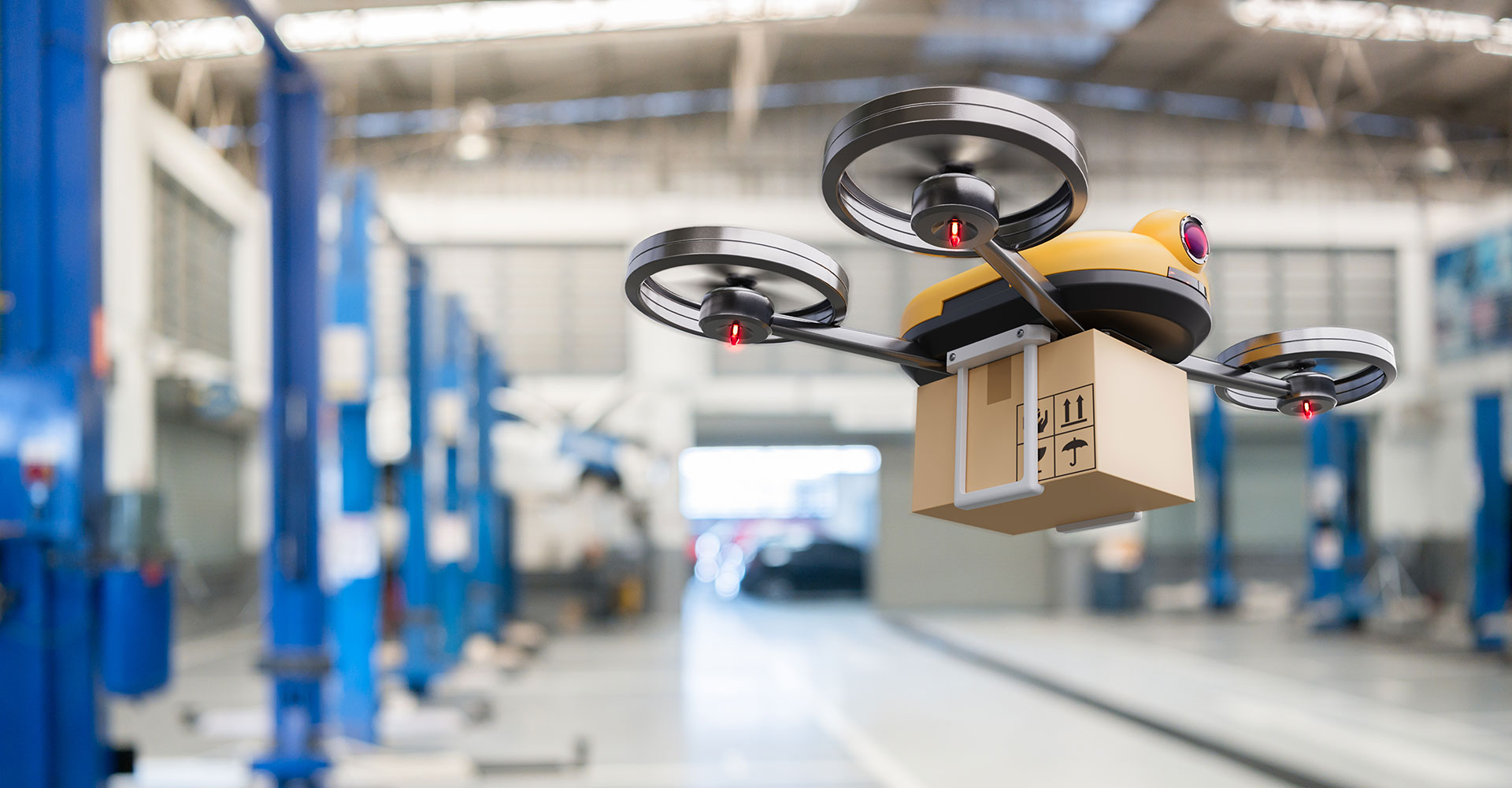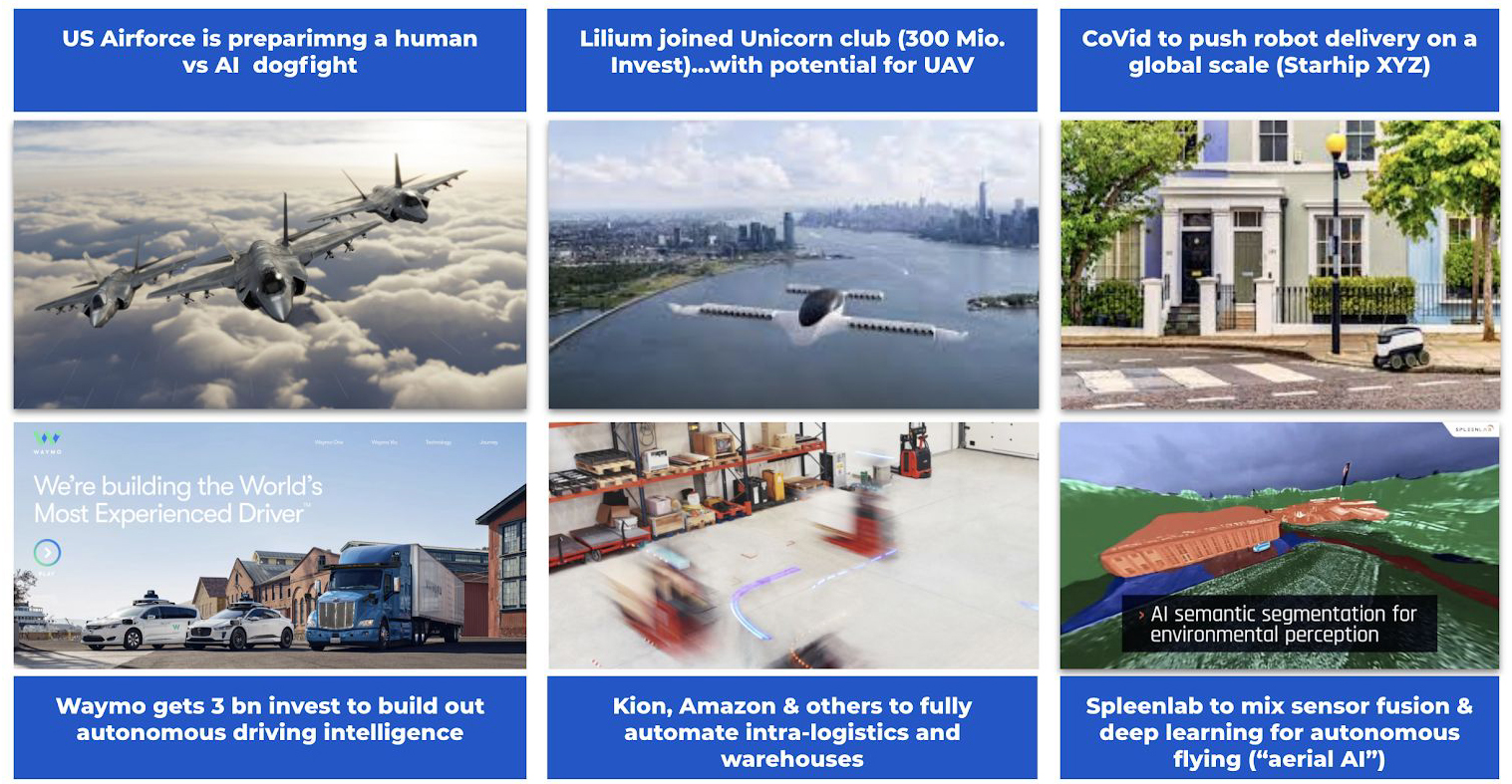The next phase of digitalization has begun
- Corona and digitalization: From contactless payment to intelligent warehouse robots – in the corona crisis, people and the environment benefit from autonomous and resource-saving logistics and mobility systems.
- From enterprise AI to autonomous AI: While machine learning has shaped the use of AI in companies in recent years, AI experts are now focusing on the use of deep learning and the development of autonomous algorithms and systems.
- Mobility becomes autonomous: Daimler partners with Nvidia, Amazon buys Zoox and Waymo raises $3 billion in fresh money – Autonomous mobility is at the center of investment and technology development and becomes the basis for new mobility and business concepts.
- Build, integrate & optimize – Steps towards automated and autonomous mobility: In addition to building internal expertise, companies need an ecosystem of external partnerships with special qualifications in the areas of sensor technology/ sensor fusion, deep learning as well as satellite data processing/ new space and autonomous driving/ flying.
Corona crisis and AI breakthroughs accelerate the trend towards autonomous systems and algorithms
In most European countries and even in North America, there has been a clear reluctance to use robots and autonomous systems. The social debate on AI has so far focused mainly on the ethical and polarizing aspects of the technology. However, this could change during and after the Corona crisis. It is now becoming clear that contactless payment, autonomous warehouse logistics in combination with cute delivery robots is not a horror scenario at all but can save lives and help to supply people.
In most cases, this technology is based on learning algorithms of the newer generation, which on the one hand make it possible to intelligently manage flows of goods in logistics centres and networks and on the other hand to develop safe, context-sensitive vehicles and robots that can move autonomously.
Considerable progress has been made in this area over the past 5 years. For example, not only the large Internet, automotive and logistics companies have been investing massively in autonomous mobility and systems for years. (see below).
Many of the world’s best minds in research and the start-up scene are also focusing on the topic. This is easy to understand because the challenges are still huge and particularly exciting. Not only praise and recognition for academic work beckons but also enormous company evaluations for start-ups with good technology. Exits in the three-digit million or billion range are not uncommon, as Amazon’s recent purchase of Zoox proves (Amazon needs the robot cars for its future autonomous logistics fleet).
Moreover, many young AI talents would like to make a contribution and help shape the mobility of tomorrow. And fortunately, this will be much smarter, more resource-efficient and environmentally friendly than we are used to today – with hours of traffic jams, nerve-wracking searches for parking spaces and a blatant waste of resources or low utilisation of our global transport and mobility capacities might soon belong to the past.
From Enterprise AI to Autonomous AI – A new phase in automation has begun
In recent decades, the “AI hype” has always been followed by a corresponding “AI winter”, i.e. a phase of cooling off of innovation and investment activities , mostly caused by a combination of exaggerated expectations and immature or poorly scalable technologies. In 2020, however, we have passed the “inflection point”, where large labelled data volumes with self-learning algorithms and massive computing power come together to make AI broadly attractive and penetrate into almost every corner of our digital world.
Even if many AI start-ups close down again after the economic crisis caused by Corona, this will no longer slow down the dynamically growing use of AI. This is also ensured by the fact that many algorithms and “machine learning-as-a-service” can be used on the global cloud platforms at the push of a button. Almost all large companies have set up data labs and started developing their own AI-based products and processes.

The past ten years have been primarily characterized by the use of machine learning in a corporate context (“Enterprise AI”). In addition to a large number of start-ups and software companies offering algorithm based solutions for the optimization and automation of various business processes (from HR to quality assurance), for the past 2-3 years it has been the companies themselves who have been building up AI know-how to improve their internal processes.
In the “Cognitive AI” phase, the systems will make a further leap forward in development, bringing them closer to human understanding, thinking and acting. For as soon as digital bots can not only translate language but also understand and deduce correlations, algorithms in images can recognize not only patterns but also any objects or even emotions, we are well on the way to making AI a real helper at business and private life.
In the last step of development, AI systems become adult or autonomous (“Autonomous AI”). This means that algorithms are given more freedom of decision and action – regardless of whether it is an algorithm for the safe navigation of a car in traffic or a trading algorithm for personal investment. At the end of the day, users or companies simply expect a system to function safely and reliably. In the field of mobility, these autonomous AI systems are now quite advanced and have an enormous potential to save resources, working and life time and enable real innovation.
Mobility becomes autonomous – How autonomous systems fundamentally change mobility and logistics
The fact that the mobility industry is facing considerable (disruptive?) changes has been clear not only since Corona. Digitalization not only allows all vehicles and users to be located in real time, thus completely reorganizing supply and demand (“Sharing Economy”). The combination of deep learning algorithms and the integration of multiple sensors (sensor fusion by means of camera, radar, lidar, etc.) already enables highly autonomous vehicles that hardly require manual driving.
- In the military sector, work and research is being carried out on autonomous fighter jets in parallel with autonomous drones. This is certainly one of the most ambitious and ethically critical areas of application for autonomous AI, but it will have long-term effects on the speed of innovation in the non-military use cases of the mobility economy (autonomous drones, air taxi business, etc.).
- Even though the commercial market for “Urban Air Mobility” or “air taxis” is still in its infancy, air taxis will be commonplace in the global mega-cities in 10-20 years’ time. In Germany, Lilium, Volocopter and others have some promising teams working in this field. In this context the city of Ingolstadt is becoming a model city for “Urban Air Mobility” and is investing in a business incubator and an incubator focusing on new aviation and mobility concepts.
- The navigation solutions and algorithms required for fully autonomous and safe drone and air-taxi flight are provided by deep tech startups such as Spleenlab. Here, know-how from the fields of autonomous driving and aviation is combined anew to create self-learning systems that can take off and land safely in real time, navigate accident-free even in difficult terrain and perform specific tasks (e.g. surveying, object recognition & evaluation etc.).
- There is also enormous potential in autonomous and AI-based warehouse logistics (intralogistics). In the huge and constantly growing warehouses and logistics centers of eCommerce and industrial companies, autonomous vehicles (forklifts, storage robots), intelligent conveyor belts, autonomous algorithms and systems for digital inventory and the optimization of routes and capacities are in high demand. The Kion Group and start-ups such as Doks Innovation are already supplying ready-made solutions.
- As Tesla has impressively demonstrated with the current delivery record of around 140,000 semi-autonomous electric cars per quarter, the market for autonomous vehicles is already growing dynamically. With significant investments by Google (Waymo), Amazon and others, the fleet of autonomous and semi-autonomous cars and trucks will increase enormously over the next 10-20 years. Driverless mobility will thus soon become an everyday phenomenon.
- In addition, there is a new generation of small autonomous delivery vehicles and robots, which bridge the last mile from the autonomous logistics center to the front door as little helpers.
Build, integrate & optimize – steps towards automated and autonomous mobility
Decision makers who want to lead their company into the age of autonomous mobility, either to become significantly more efficient in logistics processes or to establish completely new logistics and mobility services and business models, should bear in mind that there is usually no “one stop shop” for their individual situation. Rather, a whole range of new technologies must be developed, integrated and operated, for which in many cases no or not enough internal skills and personnel resources are available.
CEOs and CIOs are therefore well advised to build up internal expertise and product owners, as well as an ecosystem of external partnerships with special qualifications in the areas of sensor technology/ sensor fusion, deep learning, satellite data processing/ new space and autonomous mobility, and to fly… only then “The sky is the limit” applies!

